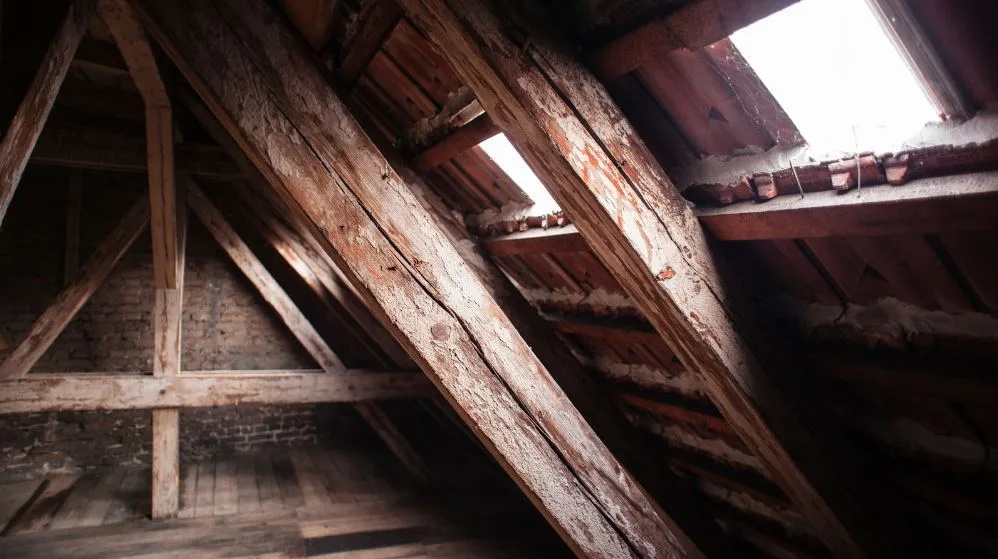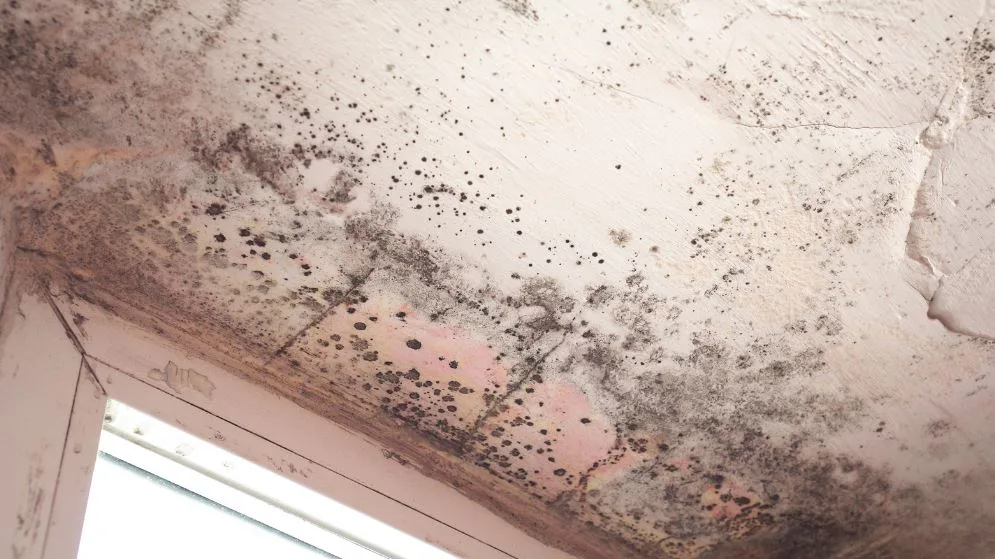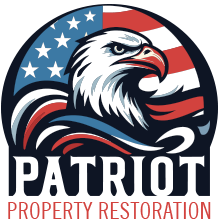Mold in the attic is a common problem in New Jersey that can be caused by improper ventilation, leaks, or other moisture-related issues. While some mold may die on its own, it’s important to know when to call in a professional, New Jersey mold remediation company like Patriot Property Restoration, LLC for help.
This article will discuss what causes attic mold and when you should consider calling in an expert to remove it. We’ll also look at how to prevent future outbreaks of mold in your attic and other areas of your home. By understanding these factors, you’ll be better equipped to make informed decisions about dealing with any potential problems with attic mold.

Is Attic Mold Dangerous?
First, let’s talk about what mold is. Mold is a type of fungus that grows in moist environments. If your attic has a leak, poor ventilation, or high humidity levels, mold can grow. Not all molds are dangerous, but some can cause health problems if you’re exposed to them for prolonged periods of time.
Some types of mold found in homes and businesses throughout Monmouth and Ocean county, New Jersey can cause allergic reactions, respiratory problems, and even infections. The most dangerous type of mold is black mold, which can produce mycotoxins that can cause serious health problems. If you suspect you have black mold in your attic, it’s important to have it removed by a professional mold remediation company so it does not change the indoor air quality.
However, not all mold is harmful. Some types of mold, like Penicillium and Cladosporium, are commonly found in homes and are generally harmless to humans. Even if you have mold in your attic, it may not be harmful to you. That being said, it’s still important to take steps to prevent mold growth in your home.
Preventing mold growth in your attic is relatively easy. First, make sure your attic has proper ventilation. This will help prevent moisture buildup and keep the humidity levels low. You should also insulate your attic to prevent cold air from mixing with warm air, which can cause condensation and moisture buildup.
Will Attic Mold Go Away?
Attic mold growth can be a serious problem for homeowners, causing not only unsightly stains and odors but also potential health risks. Many people may be wondering whether it will simply go away on its own, or if diy mold removal is a good idea but unfortunately, that is rarely the case.
Mold requires moisture, warmth, and an organic food source, meaning it won’t just disappear without intervention. In fact, if left untreated, attic mold can continue to spread and cause even more damage to your home. Mold testing by a professional mold inspector like Steve Adams from Patriot Property Restoration will reveal exactly what kind of mold you are dealing with. The good news is that with the right tools and expertise, professional mold remediation can effectively eliminate mold and prevent its return, helping you to breathe easier and enjoy a safer and healthier living environment.
How Professionals Eliminate Attic Mold
Identify the Type of Mold
The first step in eliminating mold from your attic is getting a mold inspection to identify the type of mold. Several types of mold can grow in attics, and each one requires a different removal method. This can be due to roof leaks, poor air sealing, or excessive moisture. Professionals can identify the type of mold accurately and determine the best course of action to eliminate it.
Remove Contaminated Materials
Once the type of mold has been identified, the next step is to remove all contaminated materials. Professionals will remove all damaged insulation, roof sheathing, or any other material that is affected by mold growth. This step is essential to prevent further contamination since any of it being left behind can encourage mold growth.
Contain the Work Area
To avoid spreading mold spores throughout the house, professionals will contain the work area where the mold is being removed. They use plastic sheets to seal off the area and keep the mold spores from spreading. Negative air pressure machines are also used to keep the air clean and prevent contamination.
Cleaning and Disinfecting
Professionals use specialized equipment and cleaning agents to clean and disinfect the attic space after removing the mold. They scrub out contaminated surfaces and apply strong disinfectants to kill any remaining mold spores. The final step is to dry out the area to ensure no moisture remains to create an environment for mold growth.
Prevention and Future Monitoring
After the mold has been removed and the area cleaned and disinfected, professionals will recommend a plan to prevent future mold growth. This may include installing proper ventilation systems, fixing any leaks or repairs, and monitoring the area to ensure that mold does not grow back.
Common Signs of Attic Mold
When it comes to attic mold, early detection is key to preventing further damage and health risks. Here are some common signs that may indicate the presence of mold in your attic:
- Visible Mold Growth: Look for patches or clusters of mold on the surfaces of your attic, such as walls, ceilings, insulation, or wooden beams. Mold can appear in various colors, including black, green, brown, or white.
- Musty Odors: If you notice a persistent musty smell in your attic, it could be a sign of mold growth. Mold releases volatile organic compounds (VOCs), which produce an unpleasant and distinct odor.
- Water Stains: Keep an eye out for water stains or discoloration on the walls, ceilings, or insulation in your attic. These stains indicate moisture intrusion, which creates an ideal environment for mold to thrive.
- Respiratory Issues: Mold spores can trigger allergic reactions and respiratory problems in susceptible individuals. If you or your family members experience unexplained coughing, sneezing, nasal congestion, itchy eyes, or respiratory difficulties when spending time in or near the attic, it could be due to mold contamination.
- Deterioration of Materials: Mold growth can cause materials in the attic to deteriorate over time. Watch for signs of decay, warping, or crumbling on surfaces, insulation, or structural components. Mold can weaken the integrity of these materials, potentially leading to costly repairs.
If you notice any of these signs, it’s essential to take prompt action and contact a professional mold remediation company to assess the situation and provide appropriate solutions.

What Type Of Mold Is Most Often Found In Attics
With most New Jersey attics offering an environment that is warm, dark, and often damp, mold growth is something that homeowners must always be on the lookout for. Of all the different types of mold that can be found in attics, one particular species that seems to thrive in these conditions is Stachybotrys chartarum, commonly referred to as black mold.
This toxic mold can appear as a dark green or black color, and produces mycotoxins that can cause serious health issues, including respiratory problems, allergies, and even neurological issues. Identifying black mold in your attic is crucial in order to prevent any further health risks and mold growth, and to ensure the safety and well-being of your family.
Professional Certification and Experience
When dealing with NJ attic mold removal, it’s crucial to hire a mold remediation company with proper certification and extensive experience. Here are some qualifications and expertise to look for when selecting a professional service:
Certifications:
Ensure that the mold remediation company holds relevant certifications, such as the Institute of Inspection, Cleaning and Restoration Certification (IICRC) or the National Association of Mold Remediators and Inspectors (NAMRI). These certifications demonstrate that the company has undergone specialized training and adheres to industry best practices.
Licensing and Insurance:
Verify that the company holds the necessary licenses and insurance to operate in your area. This ensures that they meet legal requirements and protects you from liability in case of any accidents or damages during the remediation process.
Experience:
Consider the number of years the company has been in the mold remediation industry. An experienced company is more likely to have encountered various mold scenarios and developed effective strategies for remediation.
Specialization in Attic Mold:
Look for a company that specifically specializes in attic mold remediation. Attics present unique challenges due to their confined spaces, insulation materials, and ventilation systems. A specialized company will have the knowledge and expertise to tackle these specific issues effectively.
Positive References and Reviews:
Read customer reviews and testimonials to gauge the reputation of the mold remediation company. Positive feedback from previous clients can give you confidence in their ability to deliver quality services.
By hiring a certified and experienced mold remediation company, you can trust that they have the necessary skills, knowledge, and techniques to handle attic mold effectively. This ensures a thorough and safe remediation process, giving you peace of mind and a healthier living environment.
Final Thoughts About Attic Mold in New Jersey
Attic mold can be a difficult problem to tackle on your own, but with the help of professional mold remediation services, you can effectively eliminate it and prevent future growth. While the cost of these services may seem steep at first glance, their expertise and specialized tools make them well worth the investment for homeowners looking for an effective solution to their attic mold problems. With just one call to a qualified exterminator, you can breathe easier knowing that your home is safe from potentially dangerous molds and other contaminants.
